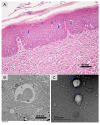Emergence of a Novel Pathogenic Poxvirus Infection in the Endangered Green Sea Turtle (Chelonia mydas) Highlights a Key Threatening Process
- PMID: 33572619
- PMCID: PMC7911307
- DOI: 10.3390/v13020219
Emergence of a Novel Pathogenic Poxvirus Infection in the Endangered Green Sea Turtle (Chelonia mydas) Highlights a Key Threatening Process
Abstract
Emerging viral disease is a significant concern, with potential consequences for human, animal and environmental health. Over the past several decades, multiple novel viruses have been found in wildlife species, including reptiles, and often pose a major threat to vulnerable species. However, whilst a large number of viruses have been described in turtles, information on poxvirus in cheloniids remains scarce, with no molecular sequence data available to date. This study characterizes, for the first time, a novel poxvirus, here tentatively designated cheloniid poxvirus 1 (ChePV-1). The affected cutaneous tissue, recovered from a green sea turtle (Chelonia mydas) captured off the Central Queensland coast of Australia, underwent histological examination, transmission electron microscopy (TEM), DNA extraction and genomic sequencing. The novel ChePV-1 was shown to be significantly divergent from other known poxviruses and showed the highest sequence similarity (89.3%) to avipoxviruses (shearwater poxvirus 2 (SWPV2)). This suggests the novel ChePV-1 may have originated from a common ancestor that diverged from an avipoxvirus-like progenitor. The genome contained three predicted unique genes and a further 15 genes being truncated/fragmented compared to SWPV2. This is the first comprehensive study that demonstrates evidence of poxvirus infection in a marine turtle species, as well as a rare example of an avipoxvirus crossing the avian-host barrier. This finding warrants further investigations into poxvirus infections between species in close physical proximity, as well as in vitro and in vivo studies of pathogenesis and disease.
Keywords: green sea turtle; poxvirus; skin lesions; species conservation.
Conflict of interest statement
The authors declare no conflict of interests.
Figures




References
-
- Australian Government Department of Agriculture, Water and the Environment: Green turtle (Chelonia mydas) [(accessed on 20 August 2020)]; Available online: https://www.environment.gov.au/marine/marine-species/marine-turtles/green.
-
- IUC Red List of Threatened Species: Green Turtle Chelonia mydas. [(accessed on 30 September 2020)]; Available online: https://www.iucnredlist.org/species/4615/11037468.
-
- Aguirre A.A., Lutz P.L. Marine turtles as sentinels of ecosystem health: Is fibropapillomatosis an indicator? EcoHealth. 2004;1:275–283. doi: 10.1007/s10393-004-0097-3. - DOI
-
- Limpus J.C., Read A.M. The green turtle, Chelonia mydas, Queensland: A preliminary description of the population structure in a coral reef feeding ground. In: Grigg G., Shine R., Ehmann R., editors. Biology of Australasian Frogs and Reptiles. Royal Zoological Society of New South Wales; Sydney, Australia: 1985. pp. 47–52.
-
- Limpus C.J., Limpus D.J., Arthur K.E., Parmenter C.J. Monitoring Green Turtle Population Dynamics in Shoalwater Bay 2000–2004. Great Barrier Reef Marine Park Authority Research Publication Series; Townsville, Australia: 2005. Research Publication No. 83.
Publication types
MeSH terms
LinkOut - more resources
Full Text Sources
Other Literature Sources
Miscellaneous

